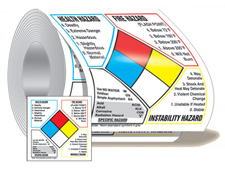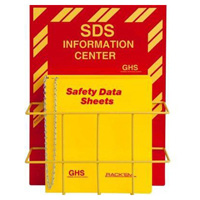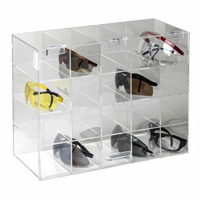| The Home page of ILPI's Safety Data Sheet (SDS) Resource, the leader in SDS information since 1995! | |
| The history and philosophy behind this resource. | |
| A curated collection of books and reference materials concerning Safety Data Sheets and closely related topics. | |
| Paste your plain text SDS into the SDS-Demystifier, and it will be converted into a hypertext-enriched document with links to detailed explanations of each key term. | |
| An extensive list of frequently asked questions about Safety Data Sheets including regulations, content, compliance, and more. | |
| A humorous take on Safety Data Sheet jargon. Fill in the blanks on our entry form to generate a personalized Unsafety Data Sheet to share with your coworkers. | |
| Since 1995, we've maintained this massive curated list of the best places to find Safety Data Sheets on the Internet. | |
| You are here! Way more than a glossary, this hypertext-enhanced resource covers hundreds of SDS-related terms and expert knowledge. Each entry includes both the SDS relevance and links to additional authoritative resources. | |
| Archived results of Safety Data Sheet related polls taken by some of our millions of site visitors | |
| The OSHA regulations behind SDS regulations, including the inspection guidelines and over 400 official interpretations letters under the Hazard Communication Standard | |
| Commercial suppliers of SDS authoring and management software as well as cloud compliance services. | |
| Commercial companies that will create SDS's for your specific needs as well as SDS translation companies. |

Safety signs, banners, and scoreboards? Get yours at Safety Emporium!
Time-Weighted Average (TWA)
Definition
- A Permissible Exposure Limit (PEL) is the maximum amount or concentration of a chemical that a worker may be exposed to under OSHA regulations.
- A Time-Weighted Average (TWA) is explained below.
- A VPEL or Vacated PEL is an older PEL set by OSHA but later "vacated" (retracted) under court order. However, some states may continue to enforce these lower levels. See below.

Communicate workplace hazards with handy labels from Safety Emporium.
Additional Info
PEL's can be defined in two different ways as discussed in the OSHA regulation on air contaminants, 29 CFR 1910.1000:
- Ceiling values - at no time should this exposure limit be exceeded. Sometimes denoted with the letter C.
- 8-hour Time Weighted Averages (TWA) - are an average value of exposure over the course of an 8 hour work shift.
TWA levels are usually lower than ceiling values. Thus, a worker may be exposed to a level higher than the TWA for part of the day (but still lower than the ceiling value) as long as he or she is exposed to levels below the TWA for the rest of the day. See 29 CFR 1910.1000 for the formulas used in the calculations.
Vacated PEL's
Analyzing the specific health risks and performing the cost/benefit analyses needed to set a PEL is a time-consuming and labor-intensive endeavor. As a result, only ~470 substances have OSHA PEL's.
In 1989, OSHA decided that it was impractical to set PEL's for tens of thousands individual chemicals and enacted a generic rulemaking scheme that broke chemicals up into various categories. This methodology was challenged in court and in AFL-CIO v. OSHA, 965 F.2d 962 the 11th U.S. District Court of Appeals vacated (struck down) the 1989 PEL revisions stating "(1) OSHA failed to establish that existing exposure limits in the workplace presented significant risk of material health impairment or that new standards eliminated or substantially lessened the risk; (2) OSHA did not meet its burden of establishing that its 428 new permissible exposure limits (PELs) were either economically or technologically feasible."
Toxicological professionals generally disagree with both of those points. With respect to the first, there was substantial documentation to support OSHA's position, and with the respect to the second, performing an economic analysis for every chemical (there are well over 100,000 commodity chemicals in use in the US) for every industry is completely infeasible. In 58:35338-35351 of the Federal Regsister OSHA noted that "...OSHA continues to believe that many of the old limits which it will now be enforcing are out of date (they predate 1968) and not sufficiently protective of employee health based on current scientific information and expert recommendations. In addition, many of the substances for which OSHA has no PELs present serious health hazards to employees."

Your employees can stay informed and comply with OSHA regulations with SDS information stations and compliance products from Safety Emporium.
Regardless, OSHA was forced to revert to the older limits. This case clearly established that to set new PEL's OSHA would need to collect specific evidence for each substance so the risk/benefit analysis could be reviewed, and the resources required for that have never been made available and likely never will be available. More information on this legal case can be found under Further Reading below.
In theory, OSHA is continuing to perform risk assessment and feasibility analysis on air contaminants in light of this court ruling, using a risk-based prioritization to identify those substances which have the most significant impact on worker safety. But in the years since this ruling, OSHA has enacted or updated PEL's for just a handful of substances.
Just to confuse matters, this decision did not directly apply to the states and territories which administer their own OSHA-approved plans. Some of these states may retain the 1989 limits. Therefore, to maximize safety and minimize potential legal problems, it is best to compare the 1989 PELs for these substances with the ACGIH limits (TLV's), and comply with whichever is most protective.
Therefore, vacated PEL values may still appear on Safety Data Sheets because some states may have enacted statutes based on their values and because some employers or employees might prefer their larger margin of safety (or error, depending on your perspective) when setting their workplace exposure limits. Whatever values you find, always err on the side of safety and choose the lower one. Remember we always want to keep chemical exposures as low as reasonably achievable (ALARA).
Books Available
NOTE: We may collect a share of sales or other compensation from the links in the following list:
- "Hazardous Materials Monitoring and Detection Devices 3rd Edition", paperback, 228 pages, 2018. Estimated price $97.16. Info and/or order .
- "Air Monitoring for Toxic Exposures", hardcover, 688 pages, 2004. Estimated price $142.66. Info and/or order .
- "Environmental Standards: Combined Exposures and Their Effects on Human Beings and Their Environment", hardcover, 409 pages, 2003. Estimated price $170.21. Info and/or order .
- "Occupational Exposure Assessment for Air Contaminants", hardcover, 360 pages, 2005. Estimated price $112.99. Info and/or order .
- "Air Sampling and Industrial Hygiene Engineering", hardcover, 296 pages, 2000. Estimated price $129.75. Info and/or order .
SDS Relevance
PEL's and any other recommended exposure limits will appear on Section 8 (exposure controls/personal protection) of that material's Safety Data Sheet. PEL's are defined by OSHA in three tables:

Make your PPE readily available with safety dispensers from Safety Emporium.
- Table Z-1 Limits for Air Contaminants.
- Table Z-2 TWA's and Ceiling Concentrations.
- Table Z-3 Mineral dusts.
In general, PEL's refer to substances that may be inhaled, although some can be absorbed through the skin or eyes. When working with materials that have an established PEL or TWA consult Section 8 (exposure controls/personal protection) of the SDS for use administrative and engineering controls to minimize the generation of a vapor or dust in the first place. If those controls are not sufficient, use the recommended personal protective equipment (PPE) such as gloves, dust masks, and respirators to limit your exposure to the chemicals.
Remember, exposure limits are not some magic threshold that define the border between safe and dangerous. A PEL that was acceptable in 1950 may be recognized as dangerously high today. Therefore, always do everything reasonable to limit the airborne airborne release of chemicals or dusts in the first place.
Further Reading
- OSHA Occupational Chemical Database at OSHA lists the PEL's and/or TWA's for many substances, health effects, and equipment/manufacturers that can monitor concentration for PEL/TWA compliance.
- SKC Guide to OSHA/NIOSH/ASTM Air Sampling Methods has information on over 2,500 compounds.
- Occupational Hygiene - Occupational Exposure Limits fact sheet from the Canadian Centre for Occupational Health & Safety.
- OSHA's Compliance and Enforcement Activities affected by the PELs Decision.
- AFL-CIO v. OSHA: Admitting Scientific Opinion as Scientific Evidence dicusses the vacated PEL case from a risk management perspective. Courtesy of the Internet Wayback Machine
- Permissible exposure limits TWA/STEL/PEL/WEEL/IDLH … What does this all mean? from Safety+Health Magazine.
See also: action level, engineering controls, inhalation, Threshold Limit Values (TLV).